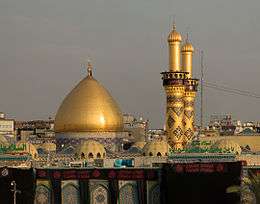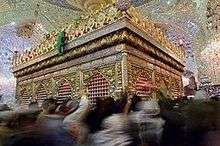Al Abbas Mosque
| Al-‘Abbās Mosque | |
|---|---|
 | |
| Basic information | |
| Location |
|
| Geographic coordinates | 32°37′1.88″N 44°2′10.38″E / 32.6171889°N 44.0362167°ECoordinates: 32°37′1.88″N 44°2′10.38″E / 32.6171889°N 44.0362167°E |
| Affiliation | Shia Islam |
The Al-‘Abbās Mosque or Masjid al-‘Abbās (Arabic: مسجد الامام العباس) is the mausoleum of ‘Abbās ibn ‘Alī and historical building, located across from the Imām Husayn Mosque in Karbalā, Iraq. ‘Abbās was son of Ali ibn Abi Talib and the half-brother of Hasan and Husayn, and was the flag-bearer for Husayn in the Battle of Karbalā. Also, he was the chief of the caravans of Husayn ibn Ali. The distance between the shrines of ‘Abbās and Husayn is the same as the distance between the hills of Al-Safa and Al-Marwah. The shrine is especially revered by the Shia who visit it every year, in the month of Muharram rather than various other times of the year.
Environmental effects over the years have caused the Euphrates river to change direction.[1] Nearly 1400 years after the Battle of Karbalā, the river flows across the grave of ‘Abbās and encircles it.[1] It is said that the Euphrates has come to ‘Abbās now.
In recent years the Shrine has undergone a series of enhancements and additions, such as the re-gilding of the dome, and more recently covering the former courtyard with a roof to accommodate pilgrims better. Each year the shrine is visited by millions of pilgrims coming from all over the world.[2]
History and design

Emperors and kings of various dynasties have offered valuable gifts and gems to the shrine of ‘Abbās. In 1622 Abbas Shah Safavi ordered the decoration of the grave's dome. He built a window around the grave and organized the precinct.[3]
The majority of the modern design was done by Persian and Central Asian architects. The central pear shaped dome is an ornately decorated structure with two tall minarets on its sides. The tomb is covered with pure gold and surrounded by a trellis of silver, along with Iranian carpets rolled out on the floors.[4] During 2008 construction work continued with the aims of creating partially gilded minarets.[5]
Renovation
Beginning in 2012 the Al Abbas mosque has undergone an extensive renovation project that has involved rebuilding the wall surrounding the shrine and turning it into a multi story building that houses museums, offices, and additional prayer halls.[6] The re-gilding of the dome and minarets, and most notably covering the shrines courtyard with a roof.[7] All to improve the shrines accommodations to the millions of pilgrims who visit the shrine every year. In April 2014 the Al Abbas Shrine Administration announced a new zarih had been completed and is to replace the current aging zarih built in 1964.[8]
In late October 2014, the Shrine saw the commencement of one of its largest projects ever. The construction of a basement intended to further accommodate pilgrims. the basement is to be located under the perimeter of the main courtyard and involves systematically closing off parts of the courtyard and then destroying the current court yard. The project is also set to deal with foundational issues of the shrine and reinforce the structure whose foundation has water gaps in it; as part of the Euphrates runs around the grave of Abbas.[9]
Timeline
| Year | Event | |
|---|---|---|
| AH | CE | |
| 61 | 680 | October 10: ‘Abbās was said to have been buried at the location on this day |
| 1032 | 1622 | Abbas Shah Safavi decorated the dome of the shrine, built glass encasings around the grave, arranged the porticoes and the yard, constructed the lobby of the first gate of the sanctuary, and sent precious carpets from Iran.[3][10] |
| 1115 | 1703 | Nadir Shah sent gifts to the shrine and had it further decorated.[10] |
| 1117 | 1705 | The vizier of Nadir Shah visited the shrine, reconstructed the porticoes, remade the encasings around the grave, and added a chandelier.[10] |
| 1216 | 1801 | Wahhabis attacked Karbalā, damaged the shrine, and robbed all precious decorative items.[10] |
| 1232 | 1817 | Fat'h ‘Alī Shāh Qājār reconstructed the dome of the shrine, gifted new chandeliers and lustrous pieces of decoration to the holy shrines, and had other constructions carried out.[10] |
| 1355 | 1936 | The custodian of the shrine, Sayyid Murtadhā, rebuilt the silver gate in the golden hallway leading towards the room of the tomb.[10] |
| 1411 | 1991 | March: A violent uprising against the regime of Saddam Hussein occurred in the city, following the Persian Gulf War. |
| 1415 | 1994 | Repairs to the shrine from the damage done in 1991 were finally completed.[11] |
| 1425 | 2004 | March 2: At least 6 explosions[12] occurred during the ‘Āshūrā' commemorations, killing 85 people and wounding 230.[13][14] |
| 1426 | 2006 | January 5: Suicide bombers among the crowd between the two shrines killed at least 60 people and injured more than 100.[15][16] |
| 1428 | 2007 | April 28: A suicide car bomber killed at least 58 people and wounded 170 others as people were heading towards evening prayers.[17][18] |
| 1429 | 2008 | September 11: A bomb was detonated 500m from the shrine which killed one civilian, wounded 3 others, and damaged buildings in the area.[19] |
| 1434 | 2012 | Construction of a roof covering the former courtyard of the Shrine began, this comes amidst many efforts by the Administration of the Al-Abbas Shrine to accommodate pilgrims better and renovate the Shrines.[20] |
| 1436 | 2014 | In late October 2014, the Shrine saw the commencement of one of its largest projects ever. The construction of a basement intended to further accommodate pilgrims. the basement is to be located under the perimeter of the main courtyard. [21] |
See also
| Wikimedia Commons has media related to Al-Abbas Mosque. |
References
- 1 2 KaraÌraviÌ, NajmulhÌ£asan (January 1, 1974). Biography of Hazrat Abbas. Peermahomed Ebrahim Trust. ASIN B0007AIWQW.
- ↑ http://www.alkafeel.net/roof/index.php?id=13
- 1 2 History of the Shrines in Karbala
- ↑ Muhammad, Yousaf (December 2001). Al-Abbas (AS) - Rajul Al-Aqidah Wal Jehad. Islamic Republic of Iran.
- ↑ مشروع تذهيب منارتي الحرم العباسي المقدس. www.alkafeel.net (in Arabic). Retrieved 2009-12-17.
- ↑ http://alkafeel.net/english/history/index1.html
- ↑ http://www.alkafeel.net/roof/index.php?id=13
- ↑ http://alkafeel.net/english/en-news/index.php?id=782
- ↑ http://alkafeel.net/english/en-news/index.php?id=1003#!prettyPhoto
- 1 2 3 4 5 6 at-Tabrizi, Abu Talib (2001). Ahmed Haneef, ed. Al-Abbas Peace be Upon Him. Abdullah Al-Shahin. Qum: Ansariyan Publications. pp. 75–76.
- ↑ Paul Lewis (August 13, 1994). "Karbala Journal; Who Hit the Mosques? Not Us, Baghdad Says". New York Times. Retrieved 15 November 2008.
- ↑ "In pictures: Karbala blasts". BBC News. 2 March 2004. Retrieved 15 November 2008.
- ↑ "Iraq Shias massacred on holy day". BBC News. 2 March 2004. Archived from the original on 3 December 2008. Retrieved 15 November 2008.
- ↑ "Deadly attacks rock Baghdad, Karbala". CNN.com. March 2, 2004 Posted: 2:41 PM EST (1941 GMT). Retrieved 15 November 2008. Check date values in:
|date=(help) - ↑ "Iraq suicide bomb blasts kill 120". BBC News. 5 January 2006. Archived from the original on 19 December 2008. Retrieved 15 November 2008.
- ↑ OPPEL Jr, RICHARD A. (January 6, 2006). "Up to 130 Killed in Iraq, Drawing a Shiite Warning". The New York Times. Retrieved 15 November 2008.
- ↑ "Car bomb attack near Shiite shrines kills dozens". CNN.com. April 29, 2007. Retrieved 15 November 2008.
- ↑ "Bomb kills many in Iraq holy city". BBC News. 28 April 2007. Retrieved 15 November 2008.
- ↑ Jomana Karadsheh (September 11, 2008). "3 killed in Iraq shrine bombings". CNN.com. Archived from the original on 14 October 2008. Retrieved 15 November 2008.
- ↑ http://www.alkafeel.net/roof/index.php?id=13
- ↑ http://alkafeel.net/english/en-news/index.php?id=1003#!prettyPhoto
| ||||||||||||||||
.jpg)
